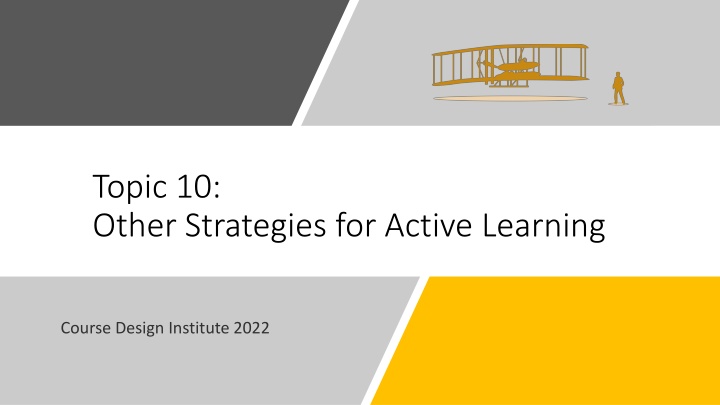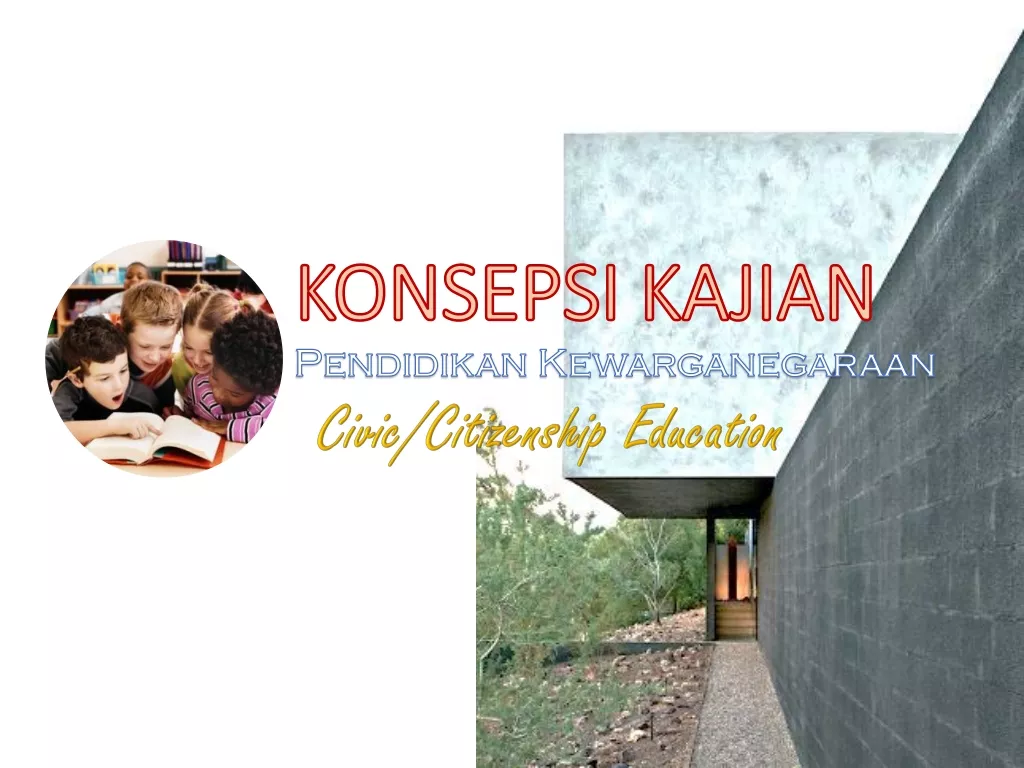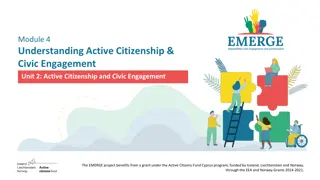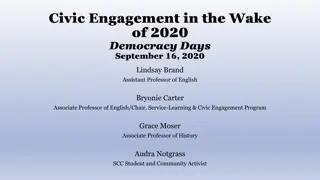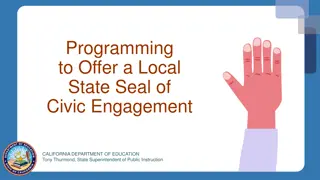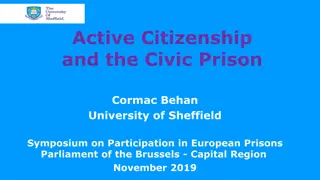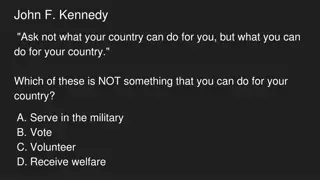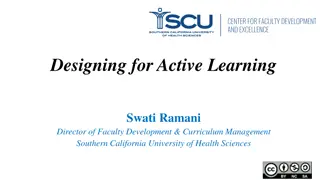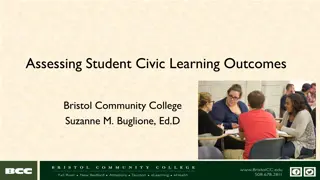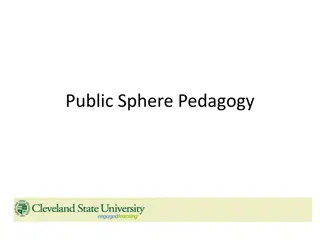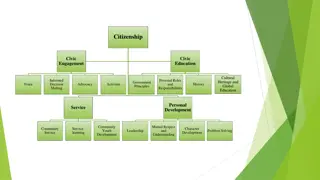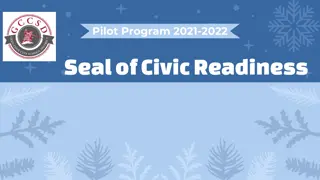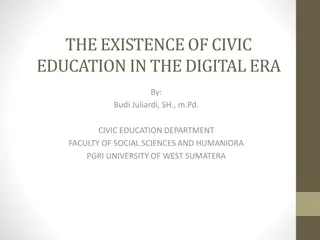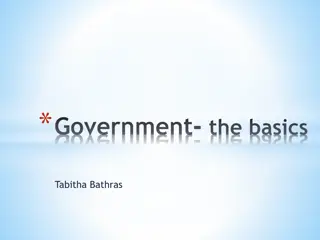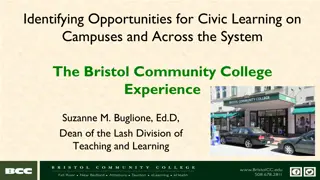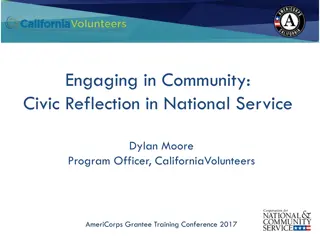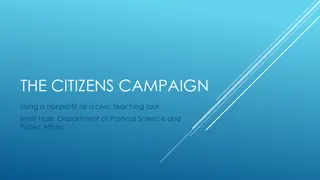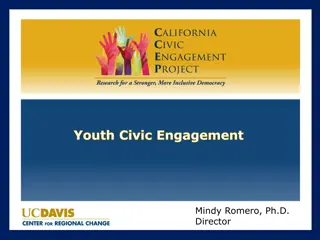Enhancing Active Learning Through Civic Engagement & Service Learning
Explore the integration of civic engagement and service learning in active learning course design for increased student engagement. Discover strategies, examples, and logistics for successful implementation in educational settings, emphasizing community connection and practical experience.
Download Presentation

Please find below an Image/Link to download the presentation.
The content on the website is provided AS IS for your information and personal use only. It may not be sold, licensed, or shared on other websites without obtaining consent from the author.If you encounter any issues during the download, it is possible that the publisher has removed the file from their server.
You are allowed to download the files provided on this website for personal or commercial use, subject to the condition that they are used lawfully. All files are the property of their respective owners.
The content on the website is provided AS IS for your information and personal use only. It may not be sold, licensed, or shared on other websites without obtaining consent from the author.
E N D
Presentation Transcript
Topic 10: Other Strategies for Active Learning Course Design Institute 2022
Serving Others
More Active Learning Collaborative learning, problem-based, and project-based learning are proven and viable strategies to increase student engagement. Next, let s consider Civic Engagement, Service-Learning, and Practical Experience.
Civic Engagement / Service Learning Both civic engagement and service learning connect the student with the community in some capacity. Tasks assigned in problem-based or project-based learning often involve engagement in the community- based or service-oriented learning opportunities. Civic engagement or service learning can co-exist or overlap with collaborative pedagogies.
Examples One-time group service projects Optional course component Required course component Action Research Project Capstone Project Multi-course project (spanning sequential semesters or involving students from multiple courses at the same time)
Preparing for Civic Engagement or Service Learning Identify and establish a relationship with a community partner, determining through open discussion how your students can best meet one or more of their needs or serve their target population meaningfully. Write outcomes and objectives for your course that students will achieve through their involvement in the planned learning experience. Address any ethical issues that may pertain to your project, ensuring the just and benevolent treatment of all persons involved. You may need to work with your institution s IRB to be certain that requirements have been satisfied.
Logistics for Civic Engagement or Service Learning Determine how you will handle issues such as: Transportation of students or project materials to and from the work site Liability concerns, including drivers licenses or insurance for those providing transportation Media coverage, either by informing the local media of the project, creating posts to social media, or publicizing the project through campus communication channels Clarifying the roles of all participants and providing for student supervision and oversight Scheduling the project, creating a master calendar and agendas for each meeting, maximizing participants time while at the job site Training or orientation that might be required by the partner organization before students can engage in the project Establishing contingency plans for when things don t go as expected and proper procedures for handling emergencies
Managing Civic Engagement or Service Learning Express any expectations and assumptions so that students, community partners, and faculty all understand what they will gain from the project. Participants should also verbalize any concerns so that these can be addressed before they become problematic. Incorporate all necessary information, documentation, and written materials in the course s design, include them in the syllabus, and provide them to all participants.
Managing Civic Engagement or Service Learning - 2 Explain required training, the work to be performed, what will occur after the completion of the project Inform students about broad issues related to the project such as the demographics and histories of the target population, including contextualization such as discussions of power and inequality Communicate all planned activities related to the project, calendars, schedules, and logistical information Incorporate instruction in problem solving, critical thinking, analysis, application, theorization, and reflection Plan for how you will assess student learning and how you will assign grades for students involvement in the project
Managing Civic Engagement or Service Learning - 3 Communicate regularly with the partnering organization, visit the project site, monitor progress, and ensure that students are functioning appropriately within the project setting. Incorporate separate opportunities for debriefing and reflection for students and participants in the partnering organization, allowing each person to think critically about their experience, relate it to larger social contexts and issues, recognize their involvement in the project s challenges and successes, and prepare for future engagement.
Practical Experience Internships Internships often involve a short-term, usually part- time, position with a company or organization related to a student s field of study. These generally last from two or three months to an entire semester or even a full academic year. Interns usually function as employees of the organization, with designated duties and some level of responsibility. Interns may receive pay or a stipend, but this varies depending on many factors. It is not unusual for an internship to lead to permanent employment, since employers are able to witness the student s work ethic and job-related skills. This Photo by Unknown Author is licensed under CC BY-NC
Practical Experience Externships Externships also involve a student in a practical work experience but are shorter in duration, lasting anywhere from a day to a week or occurring over the summer or spring break. Externships are usually unpaid and often consist of workplace observations or job-shadowing.
Practical Experience Co-Op Co-operative education (co-op) is a specialized type of internship that provides career training with pay as students work with professionals in their major field of study. Depending on the field, a co-op placement may necessitate that the student take a semester or more away from their studies, since these can be full-time paid positions.
Practical Experience Volunteering Volunteer work related to a student s field of study can also expose students to practical experience in your discipline. Co-curricular or community- based organizations abound, and most are eager for volunteers. Most campuses or their surrounding communities offer many volunteer opportunities.
Prepare for Externships Identify and build a relationship with community partners willing to host externship students for one-day job shadowing. Provide students with a list of these organizations and information for a contact person with whom the student must schedule their experience, or work with the partner organization(s) to create a schedule and assign students to given days.
Prepare for Volunteering Create a list of possible volunteer options related to the purposes of your course. Inform students of the requirement that they select and work with one of these organizations during the semester and create a means by which the student will report on this experience. The syllabus should clearly state each detail of this requirement and how it will be assessed.
Student-Led Job Shadowing or Volunteering Require students to identify and conduct their own job shadowing or volunteer experience while on an extended break from school (generally over Thanksgiving or Spring Break). Students must make these contacts on their own, undertake the experience, and then create documentation to show that they have met the requirement. Again, the syllabus should clearly state each detail of this requirement and how it will be assessed.
Study Abroad Study abroad programs are not really a strategy we can apply in our classrooms, but they are a subset of active learning that we can promote to our students. A 2018 market study revealed some surprising statistics. 13% of Americans have never flown in an airplane 50% don t own a passport 40% have never left the country 11% have never traveled outside their home state 54% have visited 10 states or less 32% don t own travel luggage A study abroad program may be some students only opportunity to expand their horizons and deepen their knowledge of other cultures through international travel, meeting degree program requirements or electives while also enriching their perspective by encountering people and places outside their everyday experiences. https://www.dailymail.co.uk/femail/article-5259681/Study-40- Americans-never-left-country.html
Engaged, Meaningful, Relevant It s one thing to sit in a classroom and listen to someone talk about human needs or problems. Going out into the community to work with people in need is an entirely different learning experience. People learn best when they can apply their learning to real-world settings and when what they re learning is personally meaningful and relevant. Civic engagement, service-learning, community-based learning, and practical engagement opportunities such as internships, externships, volunteering, and study abroad all broaden students learning beyond the walls of the classroom. The more we can infuse our curriculum with meaningful connections to the real world that give our students the chance to make a difference, the stronger their educational experience will be.
Topic 10 Task Ideation for Active Learning Use the Topic 10 Worksheet to consider how you might add other active learning strategies to the course you re designing. Share your ideas with someone nearby.
